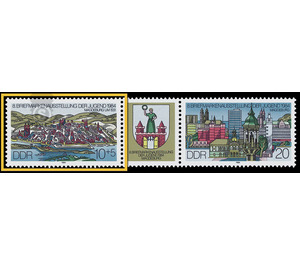Commemorative stamp series - Germany / German Democratic Republic 1984 - 10 Pfennig
Theme: Architecture
| Country | Germany / German Democratic Republic |
| Issue Date | 1984 |
| Face Value | 10.00 |
| Color | multi-colored |
| Perforation | K 13:12 1/2 |
| Printing Type | offset |
| Stamp Type | Postage stamp |
| Item Type | Stamp |
| Chronological Issue Number | 2645 |
| Chronological Chapter | GER-DDR |
| SID | 692195 |
| In 15 Wishlists | |
8. Stamp Exhibition of the Youth 1984 For the 8th Stamp Exhibition of the Youth 1984 in Magdeburg, the Ministry of Post and Telecommunications of the German Democratic Republic publishes two multicolored special postage stamps in combination with an intermediate field. The sums collected will be paid by the Philatelistenverband in the cultural association of the GDR. Special cancellation from 4 October to 3 December 1984 8th stamp exhibition of the youth of the GDR For the eighth time a large national stamp exhibition of the youth of the GDR takes place. Still Halle (1966 and 1973), Karl Marx City (1970), Gera (1976), Cottbus (1978), Zella Mehlis (1980) and Schwerin (1982) is this time Magdeburg host of the young Philatelisten. From the 6th to the 14th of October the exhibition will take place in the Kulturpark Rotehorn as a performance account of the young stamp friends for the 35th anniversary of the German Democratic Republic. The best youth exhibits from all districts of the GDR - it is to be counted on the registration of approximately 400 collections - will bear witness to how the philatelic leisure activity as part of cultural folklore proves useful in youth work, in order to convey knowledge and insights deepen their skills and abilities to contribute to the education and training of young Communists. On the topics of history and civics, art and culture, science and technology, physical culture and sports interesting and meaningful exhibits of young collectors between the ages of 10 and 25 years can be seen. In addition, there are country and special collections, exhibits on postal history, air and ship mail and chronicles on philatelic youth work. Organizer of this cultural policy contribution to the 35th Republic Birthday is the Philatelistenverband in the Cultural League of the GDR. Since the 2nd stamp exhibition of the youth of the GDR in the year 1970, postage stamps for these highlights of the Jugendphilatelie have always appeared. It is customary since the 4th exhibition 1976 in Gera to unite on two brands and an intermediate field history and present of the venue in the form of cityscapes and city coats of arms. This tradition is continued in 1984. The stamp at 10 + 5 Pfennig shows a city view of Magdeburg from the period around 1551. After the movement of the Reformation in 1521 had taken root in Magdeburg, the city stood as a member of the Schmalkaldic League of the Counter-Reformation obstinately contrary. Magdeburg was then regarded as a stronghold of Protestantism, and it refused to return to Catholicism, so that the Emperor in 1547 pronounced the Reichsacht and Magdeburg 1550/51 - at the time of the reproduced view - a one-year siege had to endure. Despite capitulation, however, the city's liberties remained intact, and until the 17th century Magdeburg, with about 3,000 houses and about 20,000 inhabitants, played an important role as one of the largest cities in Germany with a far-reaching prosperous trade. This period ended with the destruction of the city during the Thirty Years' War.


